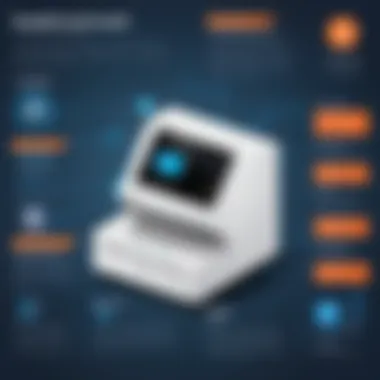Understanding POS Software for Retail Stores


Intro
Point of Sale (POS) software is a vital component for retail businesses, serving as the backbone for transaction processing and inventory management. Understanding POS systems provides insights into their capabilities and benefits, aiding decision-makers in selecting the best solutions for their operations. In this article, we will explore the key features, pricing models, and market trends. Retailers need to grasp how these systems operate to optimize efficiency and enhance customer satisfaction.
This discussion is relevant for IT professionals, entrepreneurs, and retail decision-makers who wish to stay competitive in a rapidly evolving market. By leveraging the right POS software, businesses can make informed decisions, streamline operations, and improve the overall customer experience.
Key Features and Functionalities
Comprehensive Overview
The core functionalities of POS software extend beyond simple transaction processing. These systems typically include:
- Sales tracking: Monitor real-time sales data to assess performance.
- Inventory management: Automatically update stock levels and notify when reordering is needed.
- Customer relationship management (CRM): Store customer data for personalized services and targeted marketing.
- Analytics and reporting: Generate insights from sales trends, customer behavior, and operational performance.
- Payment processing: Accept various payment methods, including credit cards, mobile payments, and digital wallets.
Understanding these features helps retailers identify which solutions align with their strategic goals.
Target Users
The typical users of POS software include:
- Retail store owners seeking to enhance operational efficiency.
- Sales staff who rely on quick and intuitive processes for customer transactions.
- IT professionals responsible for system implementation and maintenance.
- Marketing teams aiming to leverage customer data for targeted outreach.
POS systems cater to various retail environments, from small boutiques to large chains.
Pricing Models and Cost Analysis
Breakdown of Pricing Tiers
Retail POS software is often available through several pricing models:
- Subscription-based: Monthly or annual fees covering software use and updates.
- One-time purchase: A fixed fee for permanent access, usually with optional support packages.
- Pay-as-you-go: Charge per transaction, suitable for businesses with fluctuating sales.
Understanding each model can assist in selecting the right financial framework for a retail operation.
Additional Costs to Consider
Beyond basic software costs, retailers should factor in:
- Hardware expenses: Printers, scanners, and registers often incur additional costs.
- Support and maintenance: Regular updates or issues may require ongoing investment.
- Training for staff: Implementing new systems requires adequate training for users.
These elements contribute to the overall investment and should be evaluated carefully.
Summary: A well-implemented POS system is more than just a cash register. It enhances efficiency, improves customer insights, and supports data-driven decisions, making an impact that goes far beyond the point of sale.
Intro to POS Software
The landscape of retail is changing rapidly, and understanding Point of Sale (POS) software is crucial for anyone involved in the field. This section will explore the significance of POS software in retail operations. With technology at the forefront of business processes, modern POS systems are not merely cash registers. They represent sophisticated tools that manage sales, inventory, and customer relations efficiently.
Investing in effective POS software can greatly enhance operational efficiency. Retailers can track transactions in real-time, manage inventory levels precisely, and gather valuable customer data for better service. The integration of various functions into a single system streamlines workflows, allowing employees to focus more on customer interaction rather than administrative tasks.
One must also consider the adaptability of POS software to the unique needs of different retail environments. Whether a small boutique or a large multi-national chain, the software can offer scalability, flexibility, and customization opportunities. The right POS software not only supports daily operations but also aids in strategic planning by providing data-driven insights.
Looking forward, POS technology continues to evolve with trends such as cloud-based solutions and mobile integrations. These developments signify a shift towards greater connectivity and user-friendliness in the retail sector, positioning POS systems as essential tools for success.
Core Features of POS Software
In the realm of retail, Point of Sale (POS) software acts as the backbone of daily operations. Understanding the core features of POS systems is paramount for any retail business aiming to enhance efficiency and provide superior customer service. Each feature contributes significantly to streamlining processes, managing data, and ultimately driving sales. Below are key elements that merit attention.
Sales Processing Capabilities
Sales processing is one of the fundamental functions of POS software. This feature encompasses everything from transaction management to payment processing. A robust POS system allows for quick and secure transactions, an important aspect for customer satisfaction. Customers expect swift checkouts, and any delay can lead to frustration and loss of sales.
Moreover, advanced sales features include the ability to handle multiple payment methods. This can include credit cards, mobile wallets, and even loyalty points. Integration of these payment options fosters a seamless shopping experience. In addition, POS systems can often handle returns and exchanges efficiently, further enhancing customer trust.
Inventory Management Integration
Effective inventory management is essential for retail operations. POS software with integrated inventory management helps businesses track stock levels in real time. This integration minimizes the chances of stockouts or overstock situations, both of which can adversely affect revenue.
Key functionalities here include automatic stock updates upon sale and alerts for low inventory levels. Such features enable retailers to make informed purchasing decisions and reduce holding costs. By utilizing detailed reports on inventory turnover and popular items, retailers can optimize their inventory strategy to align with customer demand.
Customer Relationship Management Tools
Customer relationship management (CRM) tools within POS software can transform how retailers interact with their clientele. These tools allow businesses to collect and analyze customer data, which aids in personalizing offers and improving customer engagement.
For instance, retailers can utilize purchase history to tailor promotions or provide targeted recommendations. Furthermore, CRM features often support loyalty programs, which reward repeat purchases. By leveraging customer insights gathered through the POS system, businesses can build stronger relationships and enhance customer loyalty.


Reporting and Analytics
In today's data-driven environment, having robust reporting and analytics capabilities is crucial. POS systems that offer comprehensive reporting features allow retailers to make informed decisions based on real-time data. Such reports can cover sales performance, inventory levels, and customer behavior.
By analyzing sales trends over time, retailers can adjust their strategies accordingly. For example, they can identify peak shopping hours or seasons. This knowledge helps in workforce management and promotional planning. Moreover, reports that track employee performance can assist in recognizing high performers and areas that might need improvement.
"Data-driven decisions can significantly impact the overall success of retail operations."
In summary, the core features of POS software play a vital role in enhancing retail operations. From efficient sales processing and integrated inventory management to CRM tools and analytics, these elements collectively empower retailers to optimize their business strategies and serve their customers better.
Benefits of Implementing POS Software
Point of Sale (POS) software comes with multiple advantages for retail environments. Its implementation goes beyond merely processing transactions; it transforms various aspects of retail operations. Understanding these benefits is essential for decision-makers, IT professionals, and entrepreneurs seeking to elevate their business efficiency and customer satisfaction.
One of the primary benefits of POS systems is their ability to streamline operations. Retailers are often stretched thin with inventory management, customer service, and data analysis. POS software simplifies these tasks. It allows for automatic inventory updates, reducing the likelihood of human error. Employees can focus on engaging with customers rather than managing cash registers and manually logging sales.
Another significant benefit is the enhancement of customer experience. POS systems often integrate various customer relationship management (CRM) tools, making it easier to track purchase history and preferences. This information allows retailers to provide personalized recommendations and targeted promotions, which can improve customer satisfaction and loyalty.
The effectiveness of a retail operation often hinges on the integration of technology, and POS software stands at the forefront of this transformation.
Lastly, a well-implemented POS system can significantly boost sales performance. Many modern POS platforms provide robust analytics tools, allowing retailers to gather data-driven insights. Retailers can identify trends in sales, monitor peak business hours, and assess the performance of specific products. This information can inform strategic decisions that lead to increased revenue.
In summary, the benefits of implementing POS software are clear. Streamlined operations improve efficiency, enhancing the overall customer experience and ultimately boosting sales performance. These elements are crucial for retail success in today's competitive landscape.
Streamlining Operations
Streamlining operations is one of the most tangible benefits of POS software. Traditional methods pose challenges in efficiency and accuracy. Manual processes for tracking sales and inventory often lead to discrepancies. POS systems automate these processes. They keep real-time records of sales and stock levels, making it easy to manage operations.
Furthermore, POS software can reduce the time required for checkout. High-speed transaction processing can lead to shorter lines and a more pleasant experience for customers. The software can also track employee performance and compliance with operational standards.
POS solutions integrate with various platforms, including accounting and eCommerce systems. This integration allows for seamless data transfer, reducing duplication and save time. Retailers can maintain focus on strategic growth rather than operational chaos.
Enhancing Customer Experience
The role of customer experience in retail cannot be overstated. Modern POS systems prioritize customer engagement. They often include features such as loyalty programs and personalized marketing. These capabilities enhance the connection between the retailer and the customer. The more a business understands its customers, the better it can meet their needs.
POS software contributes to an enriched shopping experience. It helps in tracking customer interactions, enabling personalized service. For example, loyalty programs that reward repeat customers can be easily managed through POS software. This not only promotes customer retention but also encourages repeat spending.
Additionally, some POS systems allow customers to access their purchase histories. This can help customers make informed decisions in future shopping experiences. The technology supports various payment options, ensuring convenience for customers.
Boosting Sales Performance
POS software provides essential tools that contribute to boosting sales performance. Robust reporting and analytics functionalities enable retailers to gain insights into their sales data. Analyzing this data can unveil trends, enabling retailers to adjust inventory levels accordingly.
For instance, if a specific product frequently sells out, a business can invest more in that inventory. Conversely, slow-moving stock can be identified and discounted to motivate sales.
Moreover, POS systems can enable cross-selling strategies. By analyzing the purchasing behavior of customers, businesses can recommend complementary products during the checkout process. This strategy can increase average transaction values significantly.
Challenges of POS Software Adoption
Adopting a Point of Sale (POS) system in a retail environment involves various complex challenges that can significantly impact decision-making. It is crucial for retail decision-makers and IT professionals to understand these challenges, as they not only affect the implementation phase but also the long-term success of the software solution. This aspect of POS software is vital for ensuring smooth operations and maximizing return on investment. Below, we will delve into three primary challenges that organizations often face when adopting POS software: cost implications, training requirements, and technical support and maintenance.
Cost Implications
The financial aspect of adopting a new POS system cannot be overlooked. Implementing POS software often requires a substantial initial investment. This includes the cost of hardware, such as terminals, barcode scanners, and receipt printers, as well as the software license itself.
Ongoing costs related to subscription fees or maintenance agreements may also add to the budget.
- Budgeting for Implementation: Businesses must consider budgeting for both the short-term and long-term costs associated with POS software adoption. Unexpected expenses can arise, necessitating a comprehensive financial plan.
- Return on Investment: Evaluating potential ROI is essential. While the initial costs may be high, the gains from improved efficiency and increased sales can justify the expenditure over time.
Understanding these cost implications is vital for retailers. It can guide them in selecting suitable POS systems that align with their financial capabilities.
Training Requirements
Training staff to use the new POS software effectively is another significant challenge. Retail environments often have high turnover rates, which can make sustained employee training difficult. A well-trained staff is crucial for maximizing the system’s effectiveness.
- Training Programs: Developing structured training programs can help minimize resistance to new technology. This not only ensures staff proficiency but also enhances customer interaction.
- Time Management: The time invested in training should not disrupt operational flow. Balancing training schedules with peak hours is critical to maintaining productivity.
Inadequate training can lead to underuse of the system or mistakes during transactions, which may negatively affect customer satisfaction and store performance.
Technical Support and Maintenance
Ongoing technical support and maintenance are essential elements in the successful adoption of POS systems. Once the system is implemented, having appropriate channels for support is paramount.
- Vendor Support: Choosing a POS provider that offers solid technical support is important. Look for vendors that provide timely assistance and comprehensive resources.
- System Updates and Upgrades: POS software requires regular updates to function efficiently and securely. Understanding the required maintenance and how it fits into the operational budget is essential.
An absence of reliable technical support can lead to prolonged downtimes, ultimately affecting customer experience and revenue generation.


Effective management of these challenges can greatly influence the successful implementation and ongoing use of POS software.
In summary, recognizing the cost implications, training needs, and technical support requirements lays a foundation for successful adoption of POS software. Retailers must navigate these challenges carefully to optimize their systems and enhance their operational efficiencies.
Market Trends in POS Software
Understanding the current market trends in POS software is crucial for retailers seeking a competitive edge. As retail technology continues to evolve, it becomes essential for decision-makers and IT professionals to stay informed about the latest advancements. Embracing these trends can lead to enhanced operational efficiency and improved customer satisfaction.
Cloud-Based Solutions
Cloud-based POS solutions have emerged as a prominent trend in recent years. They offer retailers flexibility, scalability, and ease of access. With these systems, data is stored on remote servers rather than on-site hardware. This has several advantages:
- Cost Reduction: Lower maintenance costs as retailers no longer need to invest in extensive physical infrastructure.
- Accessibility: Users can access the system from anywhere with an internet connection, facilitating remote work.
- Automatic Updates: Software updates become seamless, as they occur in the cloud, ensuring users always have the latest features.
Retailers adopting cloud-based POS solutions often experience a smoother workflow, enabling quicker decision-making processes. Furthermore, these solutions typically provide enhanced data security, protecting sensitive customer information and payment details.
Mobile POS Systems
Another significant trend is the rise of mobile POS systems. These portable devices enable sales transactions outside traditional checkout counters. Mobile POS systems contribute to a more dynamic retail environment, offering various benefits:
- Increased Sales Opportunities: Sales associates can complete purchases directly on the sales floor, enhancing customer engagement.
- Improved Inventory Management: Retailers can check stock levels in real-time without being tethered to a specific location.
- Streamlined Transactions: The checkout process becomes faster and more efficient, reducing wait times for customers.
As consumers increasingly favor convenience and tech-savvy solutions, the adoption of mobile POS is likely to accelerate, solidifying its place in modern retail.
Integration with E-commerce Platforms
Integration with e-commerce platforms is critical for retail businesses that aim to provide a seamless omnichannel experience. This trend allows retailers to unify their in-store and online operations, resulting in:
- Consistent Customer Experience: A streamlined interface ensures customers enjoy the same level of service, regardless of their shopping channel.
- Enhanced Data Insights: Integrated systems consolidate data from various sources, allowing retailers to analyze customer behavior more effectively.
- Efficient Inventory Management: Synchronizing inventory across platforms prevents stock discrepancies, helping retailers better meet customer demand.
As e-commerce continues to grow, retailers must prioritize integration capabilities within their POS systems to stay relevant and competitive.
"Keeping up with trends in POS software helps retailers improve their strategy and adapt to changing consumer preferences."
These market trends in POS software reflect a shift towards flexibility, mobility, and integration in the retail industry. By leveraging these developments, retailers can optimize operations, enhance customer experiences, and ultimately drive sales.
Security Considerations in POS Software
In the contemporary retail landscape, the implementation of Point of Sale (POS) software comes with significant security challenges. Retailers now collect sensitive customer data and payment information, making it critical to ensure the protection of this data. A failure to properly secure the POS system can lead to data breaches, resulting in stolen personal information and financial loss. Thus, addressing security considerations in POS software is not just a matter of compliance but also a strategic initiative to maintain customer trust and safeguard business interests.
Data Encryption Practices
Encryption is vital in securing sensitive data that flows through POS systems. This process involves converting data into a coded format, making it unreadable without the proper decryption key. When a customer swipes their card, the information sent through the network can be intercepted by malicious actors. Data encryption helps prevent unauthorized access.
Common practices include:
- End-to-end encryption: This technique encrypts data from the point of capture (e.g., at the POS device) all the way to the payment gateway, keeping it secure at every stage of transaction processing.
- Point-to-point encryption (P2PE): Similar to end-to-end encryption, this method ensures that data is encrypted at the point of entry and decrypted only at secure locations, which significantly reduces the risk of data breaches.
"Properly implemented encryption can reduce the risk of cardholder data incidents dramatically, making it a cornerstone of POS security strategies."
Compliance with Payment Standards
Compliance with payment standards is essential for any retailer using POS software. The Payment Card Industry Data Security Standard (PCI DSS) outlines specific requirements that businesses must follow to protect cardholder data. Failure to comply can lead to hefty fines and loss of the ability to process credit card payments.
Key areas of PCI DSS compliance include:
- Building and maintaining a secure network: Implementing firewalls and secure passwords to safeguard the system.
- Protecting cardholder data: Ensuring that sensitive data is encrypted and stored securely, reducing exposure to theft.
- Maintaining a vulnerability management program: Regularly updating software and performing security testing.
Retailers must also engage in regular audits and assessments to ensure continued compliance as the landscape evolves. Utilizing POS systems that are certified for PCI compliance can help mitigate risks associated with non-compliance.
Addressing these security considerations is crucial for maintaining a robust and secure POS environment.
Evaluating POS Software Options
Evaluating POS software options is crucial for any retail business seeking to enhance its operational capabilities. A well-chosen POS system can directly influence the business's overall efficiency and customer satisfaction. This evaluation process involves understanding the specific needs of the business and comparing various software solutions based on those needs. This section will outline the key elements involved in evaluating POS software, focusing on identifying business needs and comparing features and pricing.
Identifying Business Needs
To begin the evaluation, identifying business needs is fundamental. Every retail environment is unique, possessing distinct challenges and requirements. Decision-makers should start by assessing areas such as:
- Sales volume: Understanding average and peak sales volumes helps determine processing capabilities needed.
- Types of products/services: Different retail environments may need specialized features, such as managing inventory or offering various payment methods.
- Customer demographics: Knowing customer behavior aids in selecting POS solutions that enhance their shopping experience.
Taking the time to outline these needs allows businesses to filter potential POS solutions that do not meet their requirements. Engaging various stakeholders, such as employees who will use the system and management, can provide comprehensive insights.
Comparing Features and Pricing


Once business needs are clear, comparing features and pricing becomes the next step. Retailers should look for specific functionalities that directly address identified needs. Key features to consider include:
- User-friendliness: An intuitive interface can significantly enhance efficiency in sales processing.
- Integration capabilities: The ability to integrate with existing systems can simplify operations.
- Support for multiple payment methods: Ensuring customer preferences are met during transactions is vital.
In addition to features, pricing plays a critical role in the evaluation process. Businesses should consider both initial costs and ongoing expenses. \nThis includes:
- Purchase or subscription fees: Understanding the payment structure helps in budgeting appropriately.
- Hardware costs: Some software may require investment in additional hardware, influencing overall expenses.
- Support and maintenance fees: Ongoing technical support can incur costs, which should be factored into the overall budget.
Evaluating POS software options thoroughly can lead to informed decisions. By carefully considering both needs and features, businesses can select a POS solution that not only meets their immediate requirements but also supports long-term growth.
"Investing time in evaluation can save money in the long run, ensuring the selected POS system aligns with business objectives and improves overall performance."
It is important to remember that the right POS choice goes beyond just the technical aspects; it can significantly impact operational efficiency and customer experiences.
Implementation of POS Software
Implementing a Point of Sale (POS) system in a retail environment is a crucial step for enhancing operational efficiency and improving customer interactions. POS software is not just a tool for processing sales; it serves as the backbone of retail operations, supporting various tasks such as inventory management, customer analytics, and financial reporting. The stage of implementation requires careful planning and consideration to align with the specific needs of the business.
By investing time and resources into a strategic implementation process, retailers can unlock numerous benefits. These include decreased transaction times, improved inventory accuracy, and enhanced data insights. It is essential to execute the implementation in stages, addressing potential challenges and ensuring that all team members are on the same page.
Planning and Preparation
Planning and preparation form the foundation of a successful POS implementation. Prior to selecting a system, businesses should conduct a thorough analysis of their operational requirements. Identify the key features that are necessary for the business, whether it's real-time inventory tracking, customer relationship management, or multi-channel sales processing.
Some key steps in this phase include:
- Assess Current Processes: Understand existing workflows to identify areas for improvement.
- Set Clear Objectives: Establish measurable goals for the new system, like reducing checkout times or improving stock management.
- Involve Team Members: Engage employees from different departments to gather diverse insights and foster buy-in.
- Budget Considerations: Determine the financial investment required and assess the return on investment.
Migration and System Integration
Migrating to a new POS system is not just about transferring data; it involves seamless integration with existing systems and processes. This phase requires attention to detail to ensure a smooth transition. Retailers must evaluate how the new POS will interact with current inventory systems, e-commerce platforms, and financial software.
When tackling migration, consider the following:
- Data Backup: Always back up existing data to prevent loss during migration.
- Phased Rollout: Implement the new system in stages to manage risks and facilitate troubleshooting.
- Integration Testing: Ensure that the new POS system communicates effectively with other business systems.
- Training Sessions: Conduct thorough training for staff to familiarize them with the new system and its functionalities.
"A well-planned POS implementation can drive significant improvements in retail operations."
Case Studies in Retail POS Applications
Case studies serve as critical tools in understanding the application of Point of Sale (POS) software within the retail sector. They provide insightful examples of how various retailers have implemented POS systems, showcasing their unique challenges, solutions, and results. Not merely theoretical, these studies highlight real-world applications and the tangible benefits realized by businesses upon implementation.
By analyzing these cases, retail decision-makers can identify best practices and pitfalls to avoid, thereby gaining valuable knowledge to inform their own strategies. Whether a small boutique or a large retail chain, the lessons derived from case studies can be adapted to fit a variety of operational contexts.
Successful Implementations
Successful implementations of POS software are often characterized by a few key factors. First, clear objectives are set. Retailers must outline what they hope to achieve through the introduction of a new POS system. This can include improving transaction speed, enhancing inventory management, or gathering customer data more effectively. For example, Target's implementation of their own POS system led to notable increases in checkout speed and customer satisfaction.
Second, a thorough assessment of the existing operational processes is crucial. This helps in molding the POS system to fit seamlessly within a retailer's specific workflow. A well-planned integration, avoiding disruption during peak hours, is essential. An example can be seen in how Starbucks upgraded their POS systems to handle mobile orders efficiently, effectively reducing wait times during rush hours.
Lastly, continuous training for staff and management cannot be overlooked. Retailers who invest time in comprehensive training programs often see higher return on their POS investments. Their employees are more confident and effective in using the new technology.
Lessons Learned
From various case studies, several common lessons emerge. One major takeaway is the importance of selecting the right software. Retailers frequently report that not all POS systems meet their needs. This underlines the necessity of identifying unique business requirements prior to making a choice.
Another lesson involves managing customer expectations. Transitioning to a new POS system can be jarring for both employees and customers. Retailers are encouraged to communicate changes effectively to their clientele. For instance, when Walmart switched to a new POS platform, they experienced an increased volume of customer inquiries which was mitigated through clear communication.
Moreover, ongoing support and updates play a significant role post-implementation. Retailers learned that systems must evolve with business growth. Failing to keep up with software advancements can lead to missed opportunities.
The Future of POS Software
The future of Point of Sale (POS) software in retail stores is poised to be transformative. As the retail landscape evolves, so does the technology that supports it. The increasing complexity of customer needs and preferences pushes retailers to adopt more sophisticated systems. Future developments in POS software are crucial for maintaining competitive advantages and enhancing customer satisfaction. The emphasis on user experience and seamless integration with existing systems is key for retailers aiming to optimize their operations.
Emerging Technologies
Emerging technologies are redefining how POS software functions. Innovations like artificial intelligence, machine learning, and Internet of Things (IoT) are slated to become commonplace. These advancements can enhance decision-making, improve inventory management, and predict customer behavior more effectively.
For instance, AI can analyze customer purchasing patterns and help retailers personalize marketing efforts, driving higher engagement rates. Similarly, IoT devices can assist in monitoring inventory levels in real-time, ensuring stock availability aligns with demand.
Retailers must also consider the growing significance of mobile technology. Mobile POS solutions can offer flexibility and accessibility, allowing staff to engage customers anywhere in the store. This trend is especially relevant as consumers increasingly favor convenience in their shopping experiences. The integration of these technology trends is essential for paving the way for effective POS systems.
Predictions for Retail POS Trends
As we look forward, several trends in POS software can be anticipated. First, the shift toward cloud-based solutions is expected to accelerate. Retailers appreciate cloud systems for their scalability and ability to reduce hardware costs. As a result, expect more retailers to migrate their POS systems to cloud environments.
Another important prediction involves the increased focus on customer data security. With growing concerns about data breaches and privacy issues, POS software will need to incorporate robust security measures. This could include enhanced encryption protocols, biometrics for user authentication, and compliance with international data protection regulations.
Moreover, omnichannel retailing will play a significant role in the evolution of POS systems. Customers expect a seamless shopping experience whether online or in-store. Future POS software will need to support this by linking all sales channels, ensuring a unified customer profile and transaction history. This integration will allow retailers to tailor their offerings to individual shopper needs more effectively.
In summary, the future of POS software looks promising, driven by technological advancements and evolving market demands. Retailers that embrace these changes and strive for continuous improvement will be well-positioned to thrive in an increasingly competitive environment.
"The integration of emerging technologies within POS systems is essential for enhancing retail operations and meeting customer expectations."















